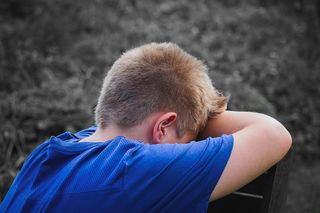Trust
What Parents Need to Know About Sexual Grooming
Understanding the stages of sexual grooming can help to protect your child.
Posted January 16, 2019 Reviewed by Ekua Hagan

In the fall of 2011, Penn State University assistant football coach Jerry Sandusky was charged with 52 counts of sex crimes against young boys. As the investigation unfurled, the public learned that Sandusky had been using grooming techniques to target and abuse vulnerable young boys that he came in contact with through his charitable foundation designed to help at-risk youth.
Since the Sandusky scandal, the term sexual grooming has gained wider public awareness. But it is important for parents to know what behaviors constitute sexual grooming and how they can be identified.
Broadly, sexual grooming refers to the behaviors that a child molester employs in preparation for committing sexual abuse against a child. It is estimated that about half of those who abuse children use grooming behaviors. Therefore, it is important for parents to be able to understand the grooming process and identify potentially predatory behaviors.
Grooming not only involves the manipulation of the intended victim, but also the child’s parents and the community at large. On the surface, child molesters who use grooming techniques often appear to be charming, kind, and helpful, and therefore these behaviors are hard to identify and, in many cases, appear innocent. It is only after the abuse is disclosed that the behaviors are reinterpreted in the context of sexual grooming. For example, Sandusky was often praised for his work with young boys through his foundation.
While there is no scientifically established model of sexual grooming, experts generally agree that grooming typically follows a series of stages such as those delineated below before the abuse actually takes place.
Victim selection. The first stage of sexual grooming often involves selecting a victim. Studies have found that victims are often selected due to their perceived physical attractiveness, ease of access, or perceived vulnerability. Children who may have less parental supervision are at particular risk. Further, child molesters may also target children who have low self-esteem, low confidence, or who may be unduly trusting or naïve. Sandusky, for example, worked with at-risk youth who lived in single-parent homes.
Gaining access. During the second stage of the grooming process, the offender seeks to gain access to the child by separating them emotionally and physically from their guardians. In cases where the child molester is a family member, they have easier access to the child. In fact, in almost half of family abuse cases, the abuse takes place in the child’s bedroom after everyone is asleep.
When the abuser is not a family member, the access stage becomes more complicated. Thus, these predators often take positions in the community where they can be in contact with minors without suspicion, such as volunteer work or employment with children, or the charitable foundation that Sandusky started for young boys. They may also befriend single parents and offer to pick up or care for the child to help the parent out.
Trust development. In the third stage of sexual grooming, the abuser works to gain the trust of the victim, their guardian(s) and the community so that they can engage in the abuse without detection. During this stage, the offender works to gain the trust of the intended victim by giving them small gifts, special attention, or sharing secrets. This makes the child feel special and gives them the belief that they have a caring relationship with the perpetrator.
These types of behaviors will change depending upon the age of the child. For younger children, it may involve playing games, going on outings, or getting presents while for adolescents it may involve the discussion of their personal lives, access to cigarettes, drugs, or alcohol, and sharing “secrets” that they don’t tell their guardians. Sandusky would often take special boys to football games or give them small gifts.
During this period, the perpetrator may also work to groom the guardian not to believe the child by telling the guardian that the child is acting out or telling lies.
Desensitization to touch. This is generally the last stage of the grooming process before the actual abuse begins. During this stage of grooming, the abuser increases the non-sexual touching that will prepare the child for the abuse. For instance, this may including hugs, snuggles, wrestling, and tickling.
Other tactics include taking a bath/shower together, swimming in the nude, drying a child off with a towel, giving massages or showing the child pornography. Sandusky was observed showering with some of his victims.
At this stage, the perpetrator may also start discussing sexual behaviors and content with the child/adolescent so that they feel more comfortable with this type of material.
Ultimately the goal of sexual grooming is to provide the perpetrator the opportunity to offend against the child without detection. In Sandusky’s case, these crimes went on for over 20 years before he was apprehended.
These sexual grooming techniques will confuse the child as they believe the person to be a friend or parent-like figure and thus they may fear that if they report the abuse that their special relationship may end.
The abuser may also use threats and coercion once the abuse starts to suggest to the victim that no one will believe them, or that the minor will be blamed for the abuse because they wanted it. As the abuser has also often groomed the victim’s guardians and community, adults often trust the perpetrator and may not be suspicious of the grooming behaviors or changes in the child’s behaviors.
The key to understanding grooming is that it is very hard to detect when it is happening as many of the grooming behaviors in and of themselves appear completely innocuous, and in many cases they are. In fact, research shows that people are generally quite poor at identifying grooming behaviors before it is revealed that abuse has occurred. It is only in hindsight that the behaviors appear suspicious.
That is why it is especially important to know who is around your children and be aware of how they are interacting with your child. While this may result in you being an overly suspicious parent, it is always better to be safe than sorry. Many child-serving organizations that have had sex scandals that involved grooming like the Catholic Church and boy scouts have now developed policies where children are not allowed to be alone with adults.
Similarly, by knowing about grooming practices, parents must keep the lines of communication with their children open and talk to them about these types of behaviors so that children know they can report anything to parents without fear of reprisal.
With the understanding of sexual grooming come some concrete suggestions for parents for keeping their kids safe:
- Children should not go alone to outings/overnights with adults that are not immediate family members. If a child goes with a family member, then it is always best when more than one relative/child attends.
- Minors with cell phones should not be receiving personal text messages or e-mails from adults in the community. If a coach or teacher uses text messages for communication, the texts should be directed at the entire group of students or parents.
- Do not encourage secret-keeping in your house. Explain to your child that if another adult tells them to keep a secret from their parent, that is wrong, and they should always let you know and that you will not be mad.
- When developmentally appropriate, talk to your children about grooming behaviors and tell them that should always tell you if anything another adult does makes them uncomfortable. Let them know that you will always believe them and take their concerns seriously.
- Be wary of other adults that show special attention to your child. While coaches or teachers may choose to single out exceptional talent, it should be in the context of the activity and they should not be providing your child with gifts or treats that are not bestowed upon all children.
- Be cautious of adults that touch your child unnecessarily. In some sporting activities, coaches may be required to touch the child to position their body or spot them, but let your child know that they should tell you if any adult is touching them in a way that makes them feel uncomfortable or doesn’t listen when they ask them to stop.
References
For more information, see: Jeglic, E.J., & Calkins, C.A. (2018). Protecting you child from sexual abuse: What you need to know to keep your kids safe. New York: Skyhorse Publishing. https://www.amazon.com/Protecting-Your-Child-Sexual-Abuse/dp/1510728686
Winters, G., & Jeglic, E.L. (2016). I knew it all along: The sexual grooming behaviors of child molesters and the hindsight bias. Journal of Child Sexual Abuse, 25(1). 20-36. doi: 10.1080/10538712.2015.1108945
Winters, G., & Jeglic, E.L (2016). Stages of sexual grooming: Recognizing potentially predatory behaviors of child molesters. Deviant Behavior, 1-10. http://dx.doi.org/10.1080/01639625.2016.1197656




